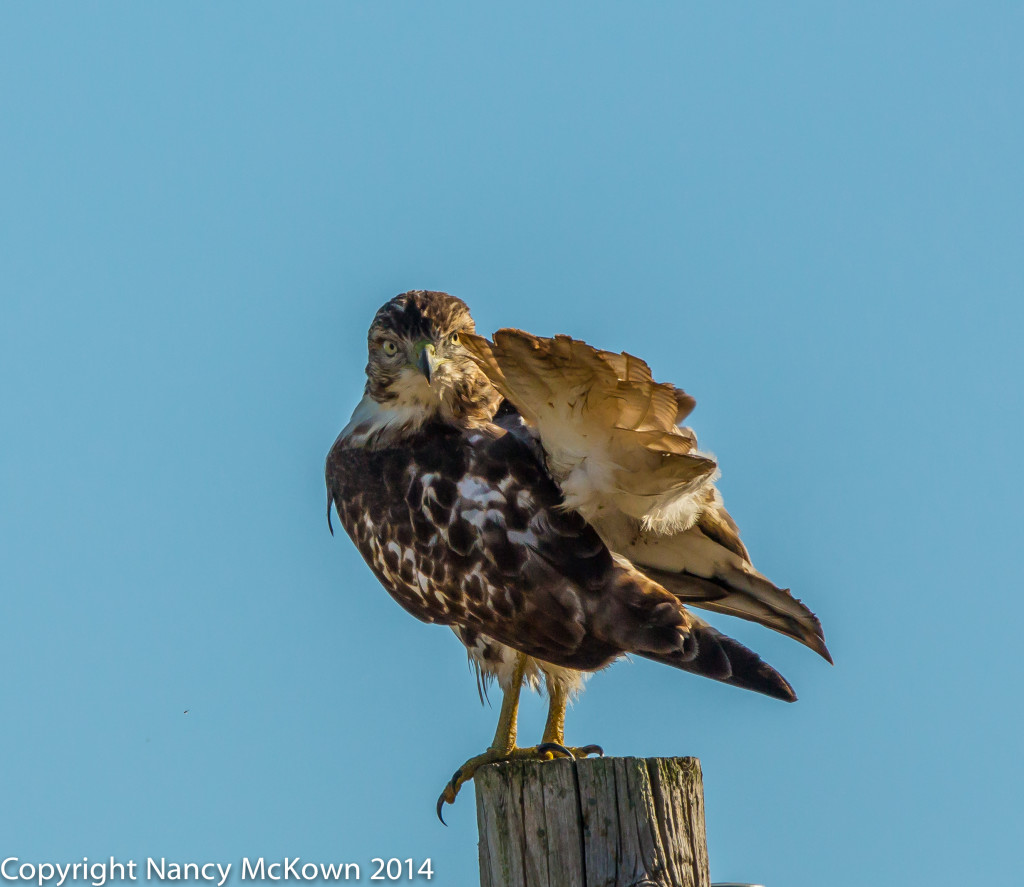Red Tailed Hawk Posing for the Camera
This Red Tailed Hawk is all curves as he poses for the camera. Anthropomorphically, I interpret this pose as being coy… you know….artfully modest to the point of being alluring. Lots of curves can make for an elegant composition. They add energy, movement, and balance to the photo.
Of course, in both of the striking poses below, this Red-Tailed Hawk was just caught in the act of preening his feathers. Still, the poses lend themselves to interesting and human centric interpretations.
For now though, I’m going to focus on exposure issues.

He Preens His Feathers.
ISO 1000; f/10; 1/2500 second
Photos Bathed in Harsh, Unbalanced Light
The late morning sun was at the hawk’s back and to my right. When I looked through the viewfinder, I could see a few details, but for the most part, the bird was a dark silhouette against a bright background. He was busy preening, so as long as I didn’t make any sudden movements, I thought the hawk would tolerate my presence.
I had some time to think about how to adjust exposure to ameliorate the harsh light; and that got me thinking about taking the time to fiddle with the camera’s Automatic Exposure Compensation (AEC) Function.
I learned something new about the quirkiness of my Canon’s Automatic Exposure Compensation function.

ISO 800; f/10; 1/2500 Second
Understanding Exposure Compensation
3 parameters control exposure: ISO, Aperture, and Shutter Speed
If you believe your camera’s sensor is misreading the light, you have options that will force your camera to override its sensor readings and interpret the light more accurately. (Assuming you don’t want to make the exposure corrections in post processing).
Overriding Your Camera’s Sensor Readings
There are two common ways to over ride sensor readings:
- YOU manually re-adjust all exposure settings (aperture, shutter and/or ISO). This is done when your camera is set to Manual “M”.
- Set the Automatic Exposure Compensation (AEC) function to temporarily over ride sensor readings. With a little help from you, the camera will calculate and then shift exposure settings. To do this, you must set your camera to one of the creative modes (“P” Program, “AV” Aperture Priority, “TV” Shutter Priority, “A+” Intelligent Auto) and then apply the Automatic Exposure Compensation function. (See specifics about how to set Automatic Exposure Compensation at this post.)
Canon Makes It Confusing
The Automatic Exposure Compensation functionality in Canon Cameras seems to me very peculiar.
I had mistakenly assumed the AEC function on my DSLR worked in Manual “M” Mode as long as I set the camera to Auto ISO. After all, the camera could adjust exposure compensation by changing the ISO. However, on most Canon Cameras, setting the AEC function does nothing at all when the camera is set to “M” Manual mode. The AEC function on the camera will not work because it will not over ride the M manual settings (aperture, shutter, ISO) the photographer has set, even if the photographer set the camera to determine the ISO (Auto ISO).
NOTE: One exception: The top of the line, professional DSLR (EOS-1D X) is the first Canon DSLR that will allow AEC in Manual mode with ISO Auto.
Auto ISO Should Not Be a “M” Manual Setting
Manual “M” mode is technically only really “manual” when the photographer is in control of all 3 exposure parameters (ISO, Aperture, Shutter). With Canon DSLR cameras, the photographer can set the ISO to “Auto ISO” even when the camera is in Manual “M” Mode.
But, if the camera is automatically making exposure decisions by adjusting the ISO, how is that Manual “M” Mode?
The problem is one of labeling. A less confusing way for Canon to manage this would be to assign the manual setting FULL control of exposure (ISO, shutter and aperture) and include another setting …perhaps an “ISO preferred” mode.
Control is an Illusion
I never did get the exposure right in this photo shoot. The Redtailed Hawk was less patient then I thought he would be and flew off after 5 minutes or so.
I have to keep reminding myself that in the art of bird photography, and in most other things in life, control is an illusion.









